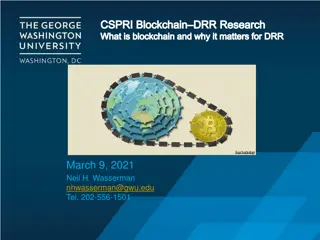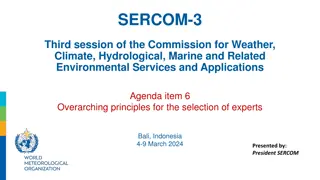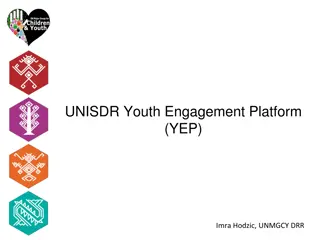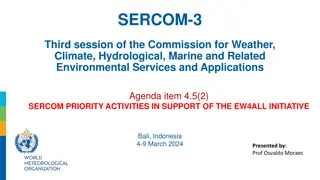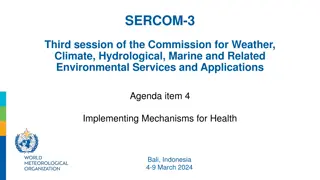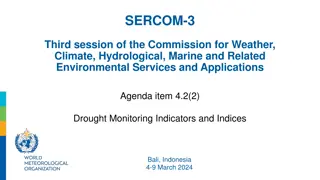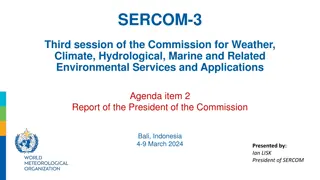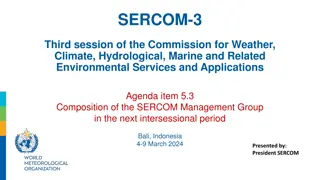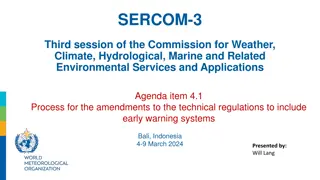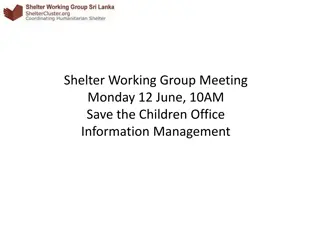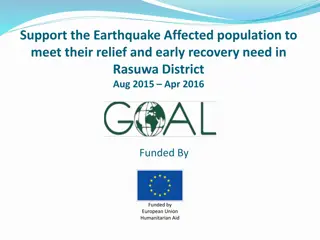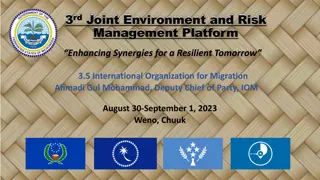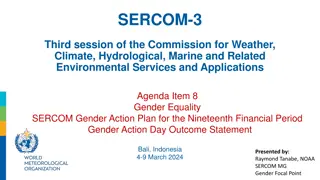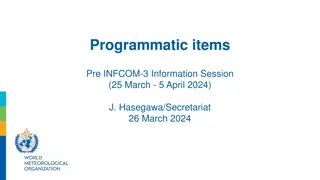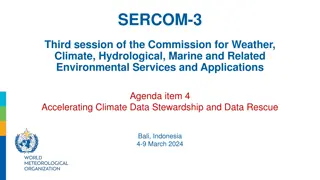Overview of SC-DRR and its Activities up to SERCOM-3
The Standing Committee on Disaster Risk Reduction (SC-DRR) is a crucial body within the Commission for Weather, Climate, Hydrological, Marine, and Related Environmental Services. It comprises various expert teams and advisory groups focused on early warning services, severe weather forecasting, and more. The committee has seen growth in membership and conducted several meetings to discuss important matters and propose recommendations. Details about its composition, membership, meetings, and responsibilities are outlined in the reports presented at SERCOM-3 in Bali, Indonesia.
Download Presentation

Please find below an Image/Link to download the presentation.
The content on the website is provided AS IS for your information and personal use only. It may not be sold, licensed, or shared on other websites without obtaining consent from the author. Download presentation by click this link. If you encounter any issues during the download, it is possible that the publisher has removed the file from their server.
E N D
Presentation Transcript
SERCOM-3 Third session of the Commission for Weather, Climate, Hydrological, Marine and Related Environmental Services and Applications Agenda item 2 - Consideration of reports 2(4) Report of the Chair of Standing Committee on Disaster Risk Reduction, and Public Services (SC-DRR) Bali, Indonesia 4-9 March 2024 Presented by: Prof. Osvaldo Moraes
Contents 1. Composition of SC-DRR 2. Membership of SC-DRR 3. SC-DRR Meetings 4. Major matters discussed within SC-DRR since SERCOM-1 5. SC-DRR proposed recommendations on resolutions/decisions for consideration at SERCOM-2 and SERCOM-3: 6. Resolutions and decisions implemented by SC-DRR 7. Publications
1. Composition/substructure of SC-DRR The SC-DRR is composed of the following bodies in its substructure until SERCOM-3: ET-EWS - Expert Team on Early Warning Services ET-MTG - Expert Team on MHEWS Technical Guidance ET-GSD - Expert Team on General Service Delivery ET-CHE - Expert Team on Cataloguing Weather, Water, Climate, Environmental and Space Weather Hazardous Events ET-WCM - Expert Team on the WMO Coordination Mechanism to support humanitarian activities of the United Nations and other organizations AG-SWF - Advisory Group on Severe Weather Forecasting AG-TC - Advisory Group on Tropical Cyclones ET-MIE - Expert Team on MHEWS Interoperable Environment ET-GMAS - Expert Team on the Global Multi-hazard Alert System Framework Noting: ET-GMAS and ET-MIE were dissolved after establishing the ET-EWS based on the Decision 8/EC-76. The areas of responsibility of the two dissolved Expert Teams were taken care of by the ET-EWS.
2. Membership of SC-DRR After SERCOM-1, SC-DRR had 11 members from 8 WMO Members (States and Territories), of five WMO Regions as follows: RA II (2), RA III (1), RA IV (2), RA V (1) and RA VI (3). After SERCOM-2, SC-DRR members increased up to 14 from 10 WMO Members (States and Territories) plus UNDRR, with regions of RA II (2), RA III (1), RA IV (3), RA V (3) and RA VI (4), and a focal point from UNDRR. The distribution of responsibilities of the 14 members of SC-DRR after SERCOM-2 is as follows: Chair (1), vice-Chair (1), members (12). Among the 12 members, 5 are the Chairs of the Expert Teams under SC- DRR, and 4 are female.
3. SC-DRR Meetings After SERCOM-1, SC-DRR organized six meetings, 1) Second Meeting of the Standing Committee on Disaster Risk Reduction and Public Services (SC-DRR-2), 6 July 2021, Online Session; 2) Second Meeting of the Standing Committee on Disaster Risk Reduction and Public Services (SC-DRR-2) - Part II, 13 14 September 2021, Online Session; 3) Third Meeting of the Standing Committee on Disaster Risk Reduction and Public Services (SC-DRR-3), 24 26 January 2022, Online Session; and 4) Fourth Meeting of the Standing Committee on Disaster Risk Reduction and Public Services (SC-DRR-4), 16 17 June 2022, Hybrid Session. 5) the sixth meeting (SC-DRR-6) online; 13 to 14 September 2023, 6) the seventh meeting (SC-DRR-7) in-person, 18-20 January 2024. Note: the Second meeting included two parts, and later was counted as two meetings. Therefore, after the fourth meeting, there was no fifth SC-DRR meeting in the series.
4. Major matters discussed within SC-DRR since SERCOM-1: 1) Outcomes of (Extraordinary) Congress, Executive Council, Technical Commissions, RAs and other valid sources; 2) Coordination and collaboration with the INFCOM and RB and other SCs for the Early Warning System (EWS) initiative, activities to support hydrological services, fire weather services, Guide for Service Delivery, Methodology for Cataloguing Hazardous Events, WMO Coordination Mechanism, MHEWS Interoperable Environment Framework, the Global Platform for Disaster Risk Reduction in May 2022 in Indonesia; 3) Establishment of two Advisory Groups (AG) AG on Tropical Cyclones (AG-TC) and AG on Severe Weather Forecasting (AG-SWF); 4) Monitoring the updates and workplans of Expert Teams ET-WCM, ET-MTG, ET- MIE, ET-GSD, ET-GMAS, ET-CHE, AG -TC and AG-SWF and ET-EWS;
4. Major matters discussed within SC-DRR since SERCOM-1: 5) Support socialization of WCM objectives with Members. 6) Advise on the connection between GMAS development and high-level advocacy efforts related to the Centre of Excellence on Climate and Disaster Resilience and the UN Secretary-General, Ant nio Guterres, call for having alerts for all in five years. 7) Partnerships with other UN humanitarian agencies such as UNDRR, OCHA, IFRC, WFP, UN Woman, EC etc., academia and private sectors. 8) Identify connections and supportive frameworks to form an ET on Wildfire including experts from SERCOM, RB, INFCOM and partners as appropriate. 9) review and revision of the Terms of the Reference (ToR) of the Expert Teams, Advisory Groups and Task Team etc.
5. SC-DRR proposed one Resolution, one Decision and five Recommendations for consideration at SERCOM-2: 1) Recommendation on WMO Guide for Service Delivery 2023 2033 (WMO-No. 1129); 2) Recommendation on Implementation Plan for the Methodology for Cataloguing Hazardous Events; 3) Recommendation on WMO Coordination Mechanism Implementation Plan; 4) Recommendation on Concept Note on MHEWS Interoperable Environment Framework; 5) Recommendation on Technical Guide on Tropical Cyclones; 6) Resolution on UN Global Warning/Adaptation Initiative; and 7) Decision (Decision 9/SERCOM-2) on Proposed Activities on Wildfires Early Warning Services.
5. SC-DRR at its 7th meeting made eight decisions of which six are recommended plus others for consideration by SERCOM-3: 1) Recommendation on SC-DRR ToRs. 2) Recommendation on Tropical Cyclone Forecasting Competency Framework 3) Recommendation on Review of the Tropical Cyclone Programme description 4) Recommendation on Guidelines on Business Continuity and Contingency Planning 5) Recommendation on Cataloguing of Hazardous Events Events list (not submitted) 6) Recommendation on Implementation Plan for the WMO Guide (not submitted) Two decisions within SC-DRR: 7) Fifth meeting of the Advisory Group on Tropical Cyclones report 8) Self-Assessment Questionnaire Template for RSMC SWF Compliance Review
5. SC-DRR at its 7th meeting made eight decisions of which six are recommended plus others for consideration by SERCOM-3: Others : 9) Proposed amendment to Technical Regulation. 10)Consolidated list of SRCOM priority activities in support of EW4ALL Initiative.
6. Resolutions and decisions implemented by SC-DRR Since the SERCOM-1, numerous documents have been received approval from the 76th and 77th sessions Executive Council, the 19th WMO Congress and SERCOM-2. The SC- DRR is tasked under SERCOM to implement those Resolutions and Decisions through its substructure. Those resolutions and decisions from SERCOM-2, EC-76, Cg-19 and EC- 77 may be highlighted as below: EC-76 Resolutions/Decisions based on SERCOM-2 recommendations Res. 2: Tropical Cyclone Forecasting Competency Framework Res. 11: WMO Guide for National Meteorological and Hydrological Services in Support of National Multi-Hazard Early Warning Systems, Procedures, Coordination Mechanisms, and Services Res. 12: Implementation Plan for the Methodology for Cataloguing Hazardous Events (WMO-CHE) with annexes -
EC-76 Resolutions/Decisions based on SERCOM-2 recommendations Res. 13: Global Multi-Hazard Alert System Framework Res. 14: WMO Coordination Mechanism Implementation Plan Res. 15: Multi-Hazard Early Warning Services Interoperable Environment Res. 17: WMO activities on extreme heat and health Decision 8: UN Early Warnings for All Initiative Follow-Up - - - - - CG-19 Resolutions/Decisions based on SERCOM recommendations Res. 4: EW4All Initiative Res. 10: WMO Strategy for Service Delivery and its implementation plan Res. 13: Amendment to the Technical Regulations (WMO-No. 49), Volume I - - - EC-77 Resolution/Decisions based on SERCOM recommendations Res. 1: WMO CONTRIBUTIONS TO EW4ALL INITIATIVE Decision 3: RESOURCE MOBILIZATION PLAN FOR THE WMO COORDINATION MECHANISM. - -
7. Publications 1) "WMO Guide for National Meteorological and Hydrological Services in Support of National Multi-hazard Early Warning Systems, Procedures, Coordination Mechanisms and Services. Guide No. 1 Tropical Cyclones. WMO-No. 1339. 2) The updated WMO Strategy for Service Delivery WMO-No. 1129. To be published soon.
Thank you. wmo.int


